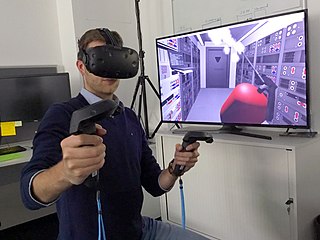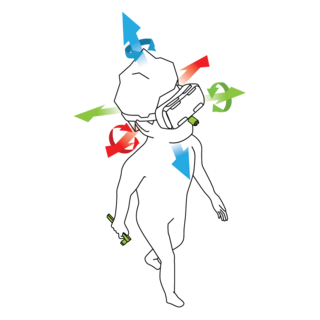Multimedia is a form of communication that uses a combination of different content forms such as text, audio, images, animations, or video into a single interactive presentation, in contrast to traditional mass media, such as printed material or audio recordings, which features little to no interaction between users. Popular examples of multimedia include video podcasts, audio slideshows and animated videos. Multimedia also contains the principles and application of effective interactive communication such as the building blocks of software, hardware, and other technologies.

Virtual reality (VR) is a simulated experience that employs pose tracking and 3D near-eye displays to give the user an immersive feel of a virtual world. Applications of virtual reality include entertainment, education and business. Other distinct types of VR-style technology include augmented reality and mixed reality, sometimes referred to as extended reality or XR, although definitions are currently changing due to the nascence of the industry.

Augmented reality (AR) is an interactive experience that combines the real world and computer-generated content. The content can span multiple sensory modalities, including visual, auditory, haptic, somatosensory and olfactory. AR can be defined as a system that incorporates three basic features: a combination of real and virtual worlds, real-time interaction, and accurate 3D registration of virtual and real objects. The overlaid sensory information can be constructive, or destructive. This experience is seamlessly interwoven with the physical world such that it is perceived as an immersive aspect of the real environment. In this way, augmented reality alters one's ongoing perception of a real-world environment, whereas virtual reality completely replaces the user's real-world environment with a simulated one.
Artificial reality is a book series by Myron W. Krueger about interactive immersive environments, based on video recognition techniques, that put a user in full, unencumbered contact with the digital world. He started this work in the late 1960s and is considered to be a key figure in the early innovation of virtual reality. For 16 years Krueger was creating a computer system that connected the actions of a user to the real-time response of visual and auditory displays. Artificial Reality was published in 1983 and updated in Artificial Reality II in 1991. Artificial Reality II was to explore the concept of 'Videoplace', which is when a users body is implemented into a computer created world full of color, sound, and visuals. Whilst the first iteration of the series Artificial Reality has laid the ground work for different branches of computer-generated worlds like Virtual Reality and Augmented Reality. Visualization is key for all artificial realities to efficiently use data; resulting in being able to utilize human sensory systems that create these artificial realities.

Computer-mediated reality refers to the ability to add to, subtract information from, or otherwise manipulate one's perception of reality through the use of a wearable computer or hand-held device such as a smartphone.
A virtual world is a computer-simulated environment which may be populated by many users who can create a personal avatar, and simultaneously and independently explore the virtual world, participate in its activities and communicate with others. These avatars can be textual, graphical representations, or live video avatars with auditory and touch sensations. Virtual worlds are closely related to mirror worlds.

A cave automatic virtual environment is an immersive virtual reality environment where projectors are directed to between three and six of the walls of a room-sized cube. The name is also a reference to the allegory of the Cave in Plato's Republic in which a philosopher contemplates perception, reality, and illusion.

Mixed reality (MR) is a term used to describe the merging of a real-world environment and a computer-generated one. Physical and virtual objects may co-exist in mixed reality environments and interact in real time. Mixed reality is largely synonymous with augmented reality.

Interactive media normally refers to products and services on digital computer-based systems which respond to the user's actions by presenting content such as text, moving image, animation, video and audio. Since its early conception, various forms of interactive media have emerged with impacts on educational and commercial markets. With the rise of decision-driven media, concerns surround the impacts of cybersecurity and societal distraction.

An omnidirectional treadmill (ODT) is a mechanical device, similar to a typical treadmill, that allows a person to perform locomotive motion in any direction, allowing for 360 degrees of movement. The ability to move in any direction is how these treadmills differ from their basic counterparts.

A virtual keyboard is a software component that allows the input of characters without the need for physical keys. The interaction with the virtual keyboard happens mostly via a touchscreen interface, but can also take place in a different form in virtual or augmented reality.
Desktop virtualization is a software technology that separates the desktop environment and associated application software from the physical client device that is used to access it.
A virtual artifact (VA) is an immaterial object that exists in the human mind or in a digital environment, for example the Internet, intranet, virtual reality, cyberspace, etc.
A virtual fixture is an overlay of augmented sensory information upon a user's perception of a real environment in order to improve human performance in both direct and remotely manipulated tasks. Developed in the early 1990s by Louis Rosenberg at the U.S. Air Force Research Laboratory (AFRL), Virtual Fixtures was a pioneering platform in virtual reality and augmented reality technologies.

Immersion into virtual reality (VR) is a perception of being physically present in a non-physical world. The perception is created by surrounding the user of the VR system in images, sound or other stimuli that provide an engrossing total environment.
A projection augmented model is an element sometimes employed in virtual reality systems. It consists of a physical three-dimensional model onto which a computer image is projected to create a realistic looking object. Importantly, the physical model is the same geometric shape as the object that the PA model depicts.
In computing, 3D interaction is a form of human-machine interaction where users are able to move and perform interaction in 3D space. Both human and machine process information where the physical position of elements in the 3D space is relevant.
Virtual reality sickness, or VR sickness occurs when exposure to a virtual environment causes symptoms that are similar to motion sickness symptoms. The most common symptoms are general discomfort, eye strain, headache, stomach awareness, nausea, vomiting, pallor, sweating, fatigue, drowsiness, disorientation, and apathy. Other symptoms include postural instability and retching. Common causes are low frame rate, input lag, and the vergence-accommodation-conflict.

In virtual reality (VR) and augmented reality (AR), a pose tracking system detects the precise pose of head-mounted displays, controllers, other objects or body parts within Euclidean space. Pose tracking is often referred to as 6DOF tracking, for the six degrees of freedom in which the pose is often tracked.

Virtual reality applications are applications that make use of virtual reality (VR), an immersive sensory experience that digitally simulates a virtual environment. Applications have been developed in a variety of domains, such as education, architectural and urban design, digital marketing and activism, engineering and robotics, entertainment, virtual communities, fine arts, healthcare and clinical therapies, heritage and archaeology, occupational safety, social science and psychology.









